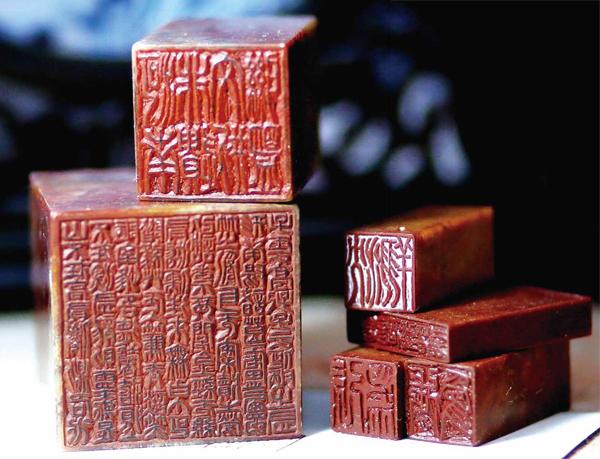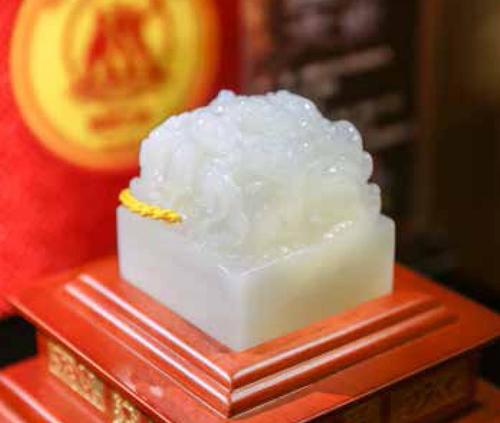Seal Carving: A Precious Art of Microcosm
2020-04-20MoTingting
Mo Tingting



Seal Carving refers to the inscription and carving of design on the bottom face of the seal, which has played a crucial, even decisive role in China's long history, and has been developed into a fine art form, comparable to Chinese painting and calligraphy. The art of carving seals is a rare pearl in the treasure-box of world art. For good and skillful seal carvings seem to come only from those good artists and calligraphers as well. In ancient times, the seal was once used as a signature or sign of authority, now it continues to be used in official documents and private correspondences, expressing the cultural ideas about humankind.
A status symbol at one time
If you still remember the dazzling opening ceremony of the 2008 Beijing Summer Olympics, you may not be unfamiliar with its official logo: a red Chinese character “Jing” which portrayed a dancing human figure. The design of the logo was inspired by the seal carving. Its history could be traced back 3,700 years ago when they originated as photographic engravings on the so-called oracle and tortoiseshell. After that, seals were made of jade or bronze and used by emperors as proof in issuing orders. Officials use seals for administration purposes to authorize documents or even as the authority and social status. There was a kind of seal called tiger tally that was a credential used for deploying military forces and generals. Special artisans began to emerge ever since, but the type of characters used on seals differs.
Later in the Qin Dynasty (221 BC-207 BC), the character was unified. Even today, this character is still being used mostly in the art of seal carving. In the Han Dynasty (202 BC-220 AC), seals became popular and were no longer made only of jade but also of gold, silver and copper. Hierarchical distinctions were apparent in the quality of the materials and the colour of the seal's ribbon.
After the Tang Dynasty (618-907), there was their way from the courts to private homes. Seals started to be used as the signature of artists to sign off and decorate their artworks. The Chinese culture is a culture that reveres its artists. It is common in most cultures to see artists sign their works; however, Chinese artists adapted the carved seal to mark their art. A painting is not considered complete unless it bears one or more of the artist's seals. A seal in red on a calligraphic work or a painting represents not only a signature, but also an indispensable touch to liven it up. There is a great deal of pride in finding a seal that is a unique and artistic expression of their work. These small patches of vermilion red usually spell out the name of the artist, sometimes the name of the studio, or a statement referring to the mood or inspiration of the artist.
Chinese seal carving is an ancient art that combines calligraphy and engraving. Seals have occupied a much more central position in Chinese culture and are still a most valued and vital tradition today. Almost every Chinese has a seal. Many business people use specially designed seals as their Chinese name stamp, to indicate their reliability as business people and to confirm their identity. No seal is quite like any other. This artistic freedom allows an unmatched advance in the art of carving non-official seals as well as the contents and the form of the inscribed character, thus turning seal into one of the most popular art forms in China.
Beauty in a small square
Seal designs are not always limited to purely characters. The themes of seals were extraordinarily rich but usually include the signature of the author, the date and place where it was made, an explanation of the contents of the seal, the authors opinion and sometimes some proverbs or aphorisms for mutual encouragement between friends. Seals also feature auspicious animal symbols carved along the edges, such as dragon, phoenix, turtle, etc. In ancient times, only a king could have a dragon on the top, and the high official would have a tiger or turtle. In some cases, since the fish was another auspicious animal, symbolizing wealth and social position, fish shapes were substituted.
Known as “the vastness in a square inch”, the art of seal carving has been engraved on a small surface. With the painstaking concern for the most minute, hairsplitting details, Chinese seal carvers ponder the infinite number of shapes, patterns, ideas and emotions they can make on a tiny carved stone of only 1 square inch or of even more dauntingly diminutive dimensions.
Carving is a skill that requires deft, steady hands, focus and patience. First, carvers should prepare materials needed: carving clamp, carving knives, soapstone, clear tracing paper and glove to protect the non-carving hand. Second, carvers should insert the block in the clamp. Third, the design is then sketched on paper, and then engraved on stone, in reverse, with a knife. The very diverse designs are the fruits of the artists imagination and culture. The art of seal carving requires demanding techniques, knowledge of Chinese history and characters, mastery of Chinese calligraphy, and essentially, time commitment. Fourth, carvers can cut and carve the images on the block. A slip of the hand means the carver will have to smooth out the surface and start all over again. On average, a seal carver takes about an hour to complete a seal, averaging about five seals a day. Apart from the main part of the seal, there are edges, handle and material used, all of which are integral parts of the seal. When these elements are perfectly combined, the result is a perfect work of art. A well-carved seal is characterized by symmetry, well-spaced characters, a balance of light and dark characters, and graceful character strokes. The arrangement, the density and spacing, the lightness or heaviness of the structure, and the judicious leaving of blank areas heighten the effect of the impression.
While seal carving is rooted in ancient Chinese cultural history, it is very much alive today and has mass contemporary appeal. The growing popularity of seal carving is creating a bright future for this ancient treasure of China.
TIPS
Key parts of Chinese seal: the top or head shape of the seal, different shapes originally based on one's class or status, who and when the seal was made; and the carved design of the seal.
Materials of seals: gold, copper, iron, jade, ivory, stone, wood, porcelain, glasstone, etc.
